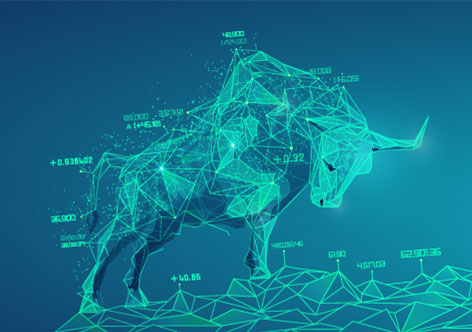Key Takeaways
- Impact of vaccine rollouts and stimulus
- Role of technology in ‘new normal’ landscape
- Recovery in global trade
- Will sustainable investing fit your portfolio?
The year of the Rat in 2020 sneaked in on us moving the proverbial cheese while upending the global status quo. To say it was an eventful year would be an understatement. Wall Street swung from record highs in February to new lows before rebounding from a bear to a bull market within weeks of hitting the trough last March. It has since been climbing up the rollercoaster incline, but not without a lot of trampoline bounces.
It was a year that saw Big Tech stocks hit the stratosphere, some rising by several folds since the first quarter of 2020 while many cyclicals sagged, in particularly those sensitive to the impact of the pandemic which were left in their dust trails. Will the year of the Ox usher in more stability as we exit the pandemic tunnel and trod ahead at a more measured pace? Let’s take a peep of what will be the market drivers and investment themes ahead.
Switching ‘Vs’
|
The V words were very much in vogue yesteryear. Foremost was of course the virus, often revolving around case counts, fatality rates and whether the infections curve can be flattened. That was of course crucial to the second V for V-shaped recovery from the slump in economic activities due to lockdown measures such as entire fleets of planes being grounded, factory assembly lines halted while restaurants, theatres and shopping either shuttered or forced to operate at restricted capacity.
The V-shaped recovery did not pan out as many had hoped, but instead took on a K-shape, one which saw a bifurcation in risk assets with clear winners (tech) and losers (cyclicals such as those in transport, energy, leisure, banks among others).
The month of January is named after the Roman god, Janus with two-faces – one looking forward and the other backwards. So it was apt that the third V for vaccine straddles 2020 and 2021 with the anxious wait for an antidote finally lifted with a pipeline of vaccines approved in succession and started to roll out at end December.
Just how successful will the outcome of these rollouts will largely determine the next leg of markets’ trajectories as they will determine the speed which economies can normalise and reopen. That is especially vital to arrest the resurgent waves of the virus which has forced renewed lockdowns as well as limited air travel which is a big part of globalisation.
The fact is that the supply side has already picked up as evident from manufacturing data coming out of the major regions from China, Europe and even the virus hard-hit USA. Demand however have yet to catch up in terms of consumer spending which contributes to large slices of many economies by way of domestic spending and tourism dollars.
For investors, that will mean the insertion of the fourth V – as in value stocks as well real estate investment trusts (REITs) in some sectors such as retail – which have been underperforming their growth counterparts ever since the onset of the pandemic and will be key components of rotational play once economies stabilise on the road to recovery.
Meanwhile tech stocks may not find it as smooth flying in the coming months in part due to their rich valuations. Tech giants such as Facebook and Google may see some headwinds from regulators which will make future acquisitions more challenging to limit their near monopolistic status. Beijing too has been cracking down on its Chinese Internet titans in its efforts to level the playing field.
Nevertheless, while those in social media and Internet commerce may see pauses as investors digest the impact of new regulatory regimes, those in hardware equipment, software and semiconductors will have room to grow due to demand and supply bottlenecks, which in the case of chipmakers partly stems from US sanctions on Chinese companies.
Further down the road, expect makers of electric automakers as well as battery makers to see increase production as demand for cleaner vehicles rises. Fintechs including digital banks and robo advisors will likely also see higher take-ups from more users.
S is for support and stimulus
|
Newton’s law relating to momentum was certainly a factor behind markets’ resilience in 2020. The underlying driving forces which propped up markets and more had sprung from the strong support from global central banks – initially by cutting interest rates before extending their loose monetary policies to provide the lifeblood for markets – providing massive global liquidity and hence easy credit for struggling businesses despite their steep decline in earnings.
Those qualitative easing measures were further augmented by fiscal policies by way of supplementary budgets from governments to help wobbling economies. The coming months will likely see two key stimulus being released – that from the new US administration and the European Union, both of which are aimed at propelling economic recovery. Both should give additional momentum to markets as they will boost business and consumer spending. Going forward, both the fiscal and monetary support pillars are expected to stay intact and will continue to fuel markets.
T for trade and techno nationalism
|
Global trade is expected to jumpstart once consumer spending normalise especially in the wake of new and bilateral regional trade agreements signed in 2020 such as the Regional Comprehensive Economic Partnership (RCEP) between Asia-Pacific nations and that between the European Union and China.
Threats and tariffs were a usual trademark of trade policy tools under the Trump administration which not only comprised some US$370 billion levied on Chinese goods but also the European Union and Canada among others for a range of exports from wine and cheese to steel and aluminum which often either met with retaliation or the US stepping back from initial quotas or making exceptions to the sanctions.
Expect the US under President Joe Biden to take more measured tones and a less aggressive stance, a multilateral rather than unilateral approach especially towards China. However, given the strong bipartisan support against China, it is likely that some of the issues especially with regards to limits to US technology exports will be left on the table.
The restrictions in some cases were also extended to US trading partners such as South Korea in areas such as semiconductors where non-US manufacturers are for instance required to seek approval from Washington before they can sell products and equipment to Chinese telecom equipment firm, Huawei and its chip-designing arm HiSilicon and chipmaker SMIC.
Some 300 Chinese companies remain on the US blacklist while three Chinese telecom companies were delisted by the New York Stock Exchange in January this year. Threats were also directed at several Chinese apps such as TikTok and WeChat among others. The upshot of all these actions may however backfire as more Chinese tech companies choose to seek new or secondary listings on exchanges in China and Hong Kong.
China has meanwhile also dished out some tariffs of its own on imports from other countries, notably Australia on agricultural products while signing an agreement with Indonesia to replace coal from the Southern continent.
S for sustainable Investing
|
Sustainable investing has been gaining traction since the onset of the pandemic which has exposed weak links across both the social and economic landscapes from not just climate and pollution related issues but also gaps in healthcare and income inequalities among others.
US President Joe Biden’s executive order to rejoin the Paris Accord on climate change as well as expected increase in federal spending and tax holidays will be a shot in the arm for businesses in the renewable energy sector. China’s latest five-year plan meanwhile aims to boost clean energy adoption while Japan has also committed to spend nearly US$1 trillion on measures that include more non-fossil fuel energy programmes.
A further driver will also come from millennial investors looking at companies and fund managers that take environmental, social and governance (ESG) factors into consideration when deciding where to place their investment.
ESG investing is not just confined to developed markets. According to a Schroders 2019 Global Investor Survey, 66% of Asian respondents indicated they would consider sustainability factors when selecting investment products, compared with 57% of global respondents. BlackRock, the world’s largest asset manager had written last year to 577 companies in the Asia-Pacific region who represent 90% of the MSCI index constituents that it expects greater sustainability disclosure from them.
With increasing pressure on companies to veer towards sustainability by end-users of their services and products at the risk of their reputation or losing their customer base in an age of social media, expect the ESG trend to become more relevant and prevalent in the investment sphere.
U for US dollar weakness
|
Progress on vaccine fronts, the Democrat Party’s sweep in the US elections and hence a tilt towards larger stimulus and US government spending coupled by the US Federal Reserve’s commitment to maintain its unprecedented accommodative monetary policy stance all point to downside momentum for the US dollar which had declined by 7% against a basket of peers in 2020.
The new US Treasure Secretary, Janet Yellen, has signaled that the new administration will likely “act big” on fiscal policies to exploit the low borrowing costs due to the low interest rate environment while letting markets determined exchange rate.
Expectations the Fed will keep rates low for an extended period for years rather than months until US employment shown marked improvement as well as optimism over multiple vaccines have eroded the greenback’s haven appeal. Anticipated higher spending by the Biden administration may also give rise to inflationary pressures that will erode the value of dollar assets (unless the Fed raises rates). All these factors may embolden investors to seek out riskier assets.
Emerging market equities and bonds will be beneficiaries of a weakened dollar which lower borrowing and costs of imports in the greenback, and will commodities though gold may lose some of its lustre. Most Asian currencies too will see gains anchored by the Chinese yuan with the US dollar also expected to slide against most G-10 currencies.
Check out these UOBAM funds for your investments here.
This publication shall not be copied or disseminated, or relied upon by any person for whatever purpose. The information herein is given on a general basis without obligation and is strictly for information only. This publication is not an offer, solicitation, recommendation or advice to buy or sell any investment product, including any collective investment schemes or shares of companies mentioned within. Although every reasonable care has been taken to ensure the accuracy and objectivity of the information contained in this publication, UOB Asset Management Ltd ("UOBAM") and its employees shall not be held liable for any error, inaccuracy and/or omission, howsoever caused, or for any decision or action taken based on views expressed or information in this publication. The information contained in this publication, including any data, projections and underlying assumptions are based upon certain assumptions, management forecasts and analysis of information available and reflects prevailing conditions and our views as of the date of this publication, all of which are subject to change at any time without notice. Please note that the graphs, charts, formulae or other devices set out or referred to in this document cannot, in and of itself, be used to determine and will not assist any person in deciding which investment product to buy or sell, or when to buy or sell an investment product. UOBAM does not warrant the accuracy, adequacy, timeliness or completeness of the information herein for any particular purpose, and expressly disclaims liability for any error, inaccuracy or omission. Any opinion, projection and other forward-looking statement regarding future events or performance of, including but not limited to, countries, markets or companies is not necessarily indicative of, and may differ from actual events or results. Nothing in this publication constitutes accounting, legal, regulatory, tax or other advice. The information herein has no regard to the specific objectives, financial situation and particular needs of any specific person. You may wish to seek advice from a professional or an independent financial adviser about the issues discussed herein or before investing in any investment or insurance product. Should you choose not to seek such advice, you should consider carefully whether the investment or insurance product in question is suitable for you.






